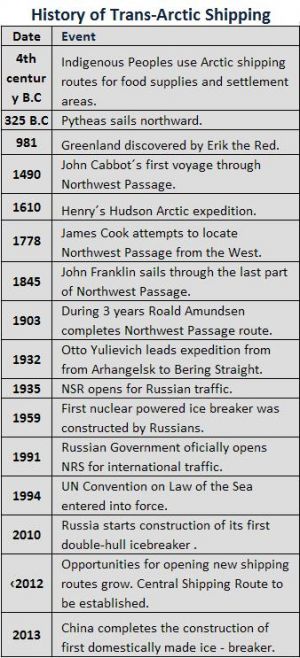Trans-Arctic marine shipping operations are not a new phenomenon. Although there seems to be no written evidence of indigenous expeditions, the oral knowledge, delivered by Northern Canadians, Russian Chukchi and Yukaghirs has survived through the centuries.
Indigenous Peoples, Inuit and Mongolians, were first to discover the marine routes through the North, which were used mostly for delivering community supply, searching for food and new settlement areas.
For marine operations, they used kayaks and small man-powered boats with covered decks, which did not have ice breaking capabilities but were light and easy to carry over the ice.
Ancient European Encounters: Pytheas and the Idea of the North
The first European marine explorer was Pytheas in 330BC, who is thought to be the first one to try to reach the North Pole. He was a Greek astronomer and geographer who had worked out a method of calculating latitude by measuring the shadow cast by a vertical pillar at solstice. He had an idea of Thule, a place where the sun did not set in the summer and never came up in the winter and was the first one to describe the midnight sun and polar ice.
His journey began in Marseille, France (then named Massalia) and lasted for six years. He reached Britain, kept heading north and reached a place he called Orcas, which are probably Orkney Islands. He reached also another destination, but it is debated where he actually landed. Possibly his final destination was Norway, some say Iceland, but that is highly unlikely since he sailed for only six days from Orcas. Yet another say it was the Shetland Islands.
The Quest for the Northwest Passage Begins
It was not until the late 15th century when first European explorers started to consider the Northwest Passage as a possible shortcut between Asia and Europe. The first attempt to sail straight from Europe to Asia through North America and Canadian archipelago, executed by Italian explorer Giovanni Cabot, failed due to impassable sea ice at the north coast of Canada.
The Age of Exploration: Cook, Franklin and Amundsen
Exploration of Arctic waters did not bring any results until the 18th century, when British captain James Cook decided to explore the northern Pacific Ocean. Captain Cook started his journey from Great Britain and after few months he arrived at Capetown in South Africa, from where he sailed through the Indian Ocean to New Zealand, the Cook Islands and Tonga, all the time heading for Alaska. Cook never reached Alaska, his journey ending in Hawaii in 1779. He never thus fully explored the route, but his expedition had significant impact on the future explorations.
In 1845, another British polar explorer, John Franklin, sailed through the last non navigated part of Northwest Passage, proving its accessibility. Unfortunately Franklin´s expedition did not survive the journey, but it became the bedrock for the 20th century scientific researches and inspiration for Roald Amundsen voyage, who at the very beginning of the 20th century managed to complete the Northwest Passage from Eastern to Western part of the world. In 1942, when Japanese Navy attacked Colombo in Sri Lanka and assaulted United States on Bataan Peninsula, the transit from West to East was completed by Henry Larsen.
Military Influence and Strategic Passage: World War II and Beyond
In the 19th century, the first steam-powered icebreakers were designed. They were made to be pushed by the engines over the ice and break it, consequently.
After World War II, Canadians started to use their first diesel-electric ice-breakers, but it was not until the early 1990s when North Americans sailed through the Northwest Passage with modern oil tankers. Northwest Passage became thus a reality and brought together governments of the Arctic coastal states as well as industry, to create unflinching international standards to govern the operations and constructions of vessels operating in Arctic waters.
At the same time as the opportunities for the Northwest Passage were being discovered at the beginning of the 20th century, the Northern Sea Route on the Russian side started to become a reality. In 1932, a Russian expedition led by Otto Yulievich sailed from Arkhangelsk to Bering Strait.
The Northern Sea Route: Russia´s Arctic Gateway
Following the Northern Sea Route was officially opened in 1935. The Russian Government held administration over the Route, which became formally open for foreign vessels in the summer of 1991, only a few months before the Soviet Union was dissolved.
After historical changes connected to the end of the communist era, the establishment of international organizations like the International Maritime Organization, the United Nations, and the European Union, all have great interest and impact on marine transportation, there was a need to regulate marine traffic in the Arctic.
Governance and Law of the Sea
After several attempts to codify the maritime customary law, the final version of the United Nations Convention on the Law of the Sea entered into force in 1994. By the year of 1998, the Convention was ratified by 127 states. In addition, parts of the Convention have now reached a status of customary international law and bind also states that have not ratified the Convention, i.e., the U.S.
There is still ongoing development of navigation through the ice-covered waters as the demand for cutting down the distance between the most important world´s hub ports is increasing. Future possibilities are mostly dependent on climate change factors, as a significant reduction of ice thickness could bring the opportunity for navigation straight through the Central Arctic.
Improvement of existing technologies is also the determinant, as vessels need to be able to navigate in the Arctic Ocean in the near future. According to the latest news, Russia did start to build their first nuclear-powered ice-breaking vessel, which is due in 2015, while the Chinese one should come into use in early 2013.








